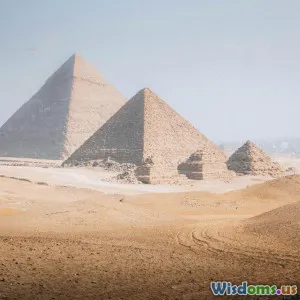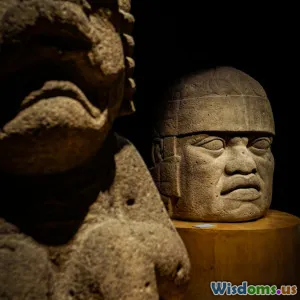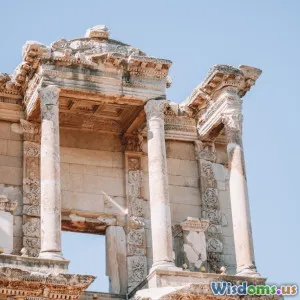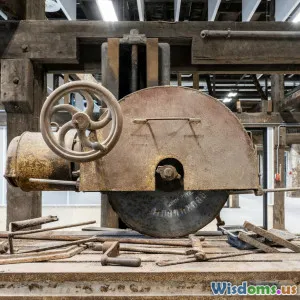
Are Hidden Chambers Still Lurking in the Great Pyramid
8 min read Explore the latest discoveries and scientific efforts to uncover hidden chambers within Egypt's Great Pyramid. (0 Reviews)
Are Hidden Chambers Still Lurking in the Great Pyramid?
Introduction
For thousands of years, the Great Pyramid of Giza has captivated minds worldwide—it stands not only as an architectural marvel but as a beacon of mystery. Among the many puzzles it holds, one of the most tantalizing questions remains: Are there hidden chambers still lurking within this ancient wonder? Despite extensive exploration and research, many believe that the pyramid may harbor undiscovered spaces that could provide new understanding of ancient Egyptian civilization. This article delves into the latest investigations, historical context, and scientific discoveries related to potential secret chambers hiding within one of humanity's oldest and most iconic monuments.
The Historical Significance of the Great Pyramid
The Great Pyramid, constructed around 2580–2560 BCE during Pharaoh Khufu’s reign, is the largest of the three pyramids in the Giza complex. Measuring approximately 146 meters tall originally, its precise architecture and massive scale have posed countless questions to archaeologists and historians alike. The pyramid served primarily as Khufu's tomb and was intended to ensure his immortality and divine passage to the afterlife.
Over centuries, the pyramid was penetrated by treasure hunters, early archaeologists, and modern scientists, revealing burial chambers, shafts, and corridors. Yet, the structure’s immense complexity, coupled with limitations of earlier technology, led to many areas being inaccessible or unidentified.
Exploring the Known Chambers: Insights and Gaps
Three major chambers were discovered in the Great Pyramid before the 20th century:
- The King's Chamber: The main burial chamber, made of red granite blocks, hosting the famous granite sarcophagus.
- The Queen's Chamber: Its purpose remains debated—some suggest a secondary burial site or symbolic space.
- The Subterranean Chamber: Located below ground level with uncertain function.
While these chambers have been extensively studied, they are not the entirety of the pyramid’s internal architecture. The maze of corridors and shafts hint at further possibilities yet to be uncovered.
Modern Technologies Unveil New Possibilities
Muon Radiography—Peering Through Stone
In 2017, an international team using muon radiography—a technique using cosmic-ray muons that pass through rock—detected a previously unknown void above the Grand Gallery. This unexpected chamber measured at least 30 meters long and sparked worldwide excitement.
Professor Kunihiro Morishima, who led this discovery, called it "a big new hall," emphasizing the importance of further exploration. The existence of this void challenges previous assumptions that the pyramid's interior was fully mapped.
Robot Explorations and 3D Modeling
Concurrently, robotics has advanced the ability to explore narrow shafts inaccessible to humans. Robots like Djedi have investigated air shafts and discovered markings, possible doors, and enigmatic symbols inside these secret passageways.
Three-dimensional modeling and ground-penetrating radar (GPR) surveys have been used to analyze the pyramid's structure without causing damage, refining our map of known spaces and identifying anomalies indicative of hidden voids.
Theories Regarding Hidden Chambers
What might these concealed spaces contain if they exist? Several theories have emerged:
- Additional Burial Chambers: Some scholars speculate that a secret chamber could house Khufu’s remains or other royal burials, given that the confirmed chambers lack mummies or grave goods.
- Architectural Necessities: Hidden voids could be structural elements designed to relieve stress or support weight, not intended as chambers.
- Symbolic or Ritual Spaces: The pyramid’s internal design might have symbolic meaning, with concealed chambers representing spiritual concepts, ascension, or serving unknown ceremonial purposes.
The diversity of these theories reflects the ongoing debate fueled by discoveries.
Challenges in Uncovering Hidden Chambers
Preservation Concerns
The Great Pyramid is an invaluable UNESCO World Heritage site; intrusive exploration risks irreparable damage. Hence, non-invasive techniques like muon radiography and GPR are favored, though they have resolution limits.
Access Limitations
Many potential chambers are located in tight shafts or thick masonry, making physical access difficult. Robotic explorers may sometimes encounter obstacles impossible to navigate or penetrate.
Interpretative Ambiguity
Data from scans can show anomalies, but interpreting these requires careful analysis to avoid misidentifying natural voids as chambers or attributing symbolic meaning to structural necessities.
Why Hidden Chambers Matter
Insight into Egyptian Engineering
Finding new chambers could enlighten us about the advanced engineering skills of pyramid builders and reveal their unknown construction techniques.
Understanding Royal Burial Practices
If new burial chambers are found, researchers could gather much-needed evidence about royal funerary rituals, use of tombs, and any secondary internments.
Cultural and Historical Impact
Beyond academic curiosity, unlocking secrets of the Great Pyramid would enhance our appreciation of Ancient Egypt’s culture and influence tourism, inspiring new generations to study and protect ancient heritage.
Conclusion
The idea that hidden chambers might still lurk within the Great Pyramid strikes the perfect balance between wonder and scientific inquiry. While technology has revealed new voids and yet-to-be-explored spaces, the mystery far from completely solved. As non-invasive methods improve and robotic explorers gain sophistication, our chances of uncovering these enigmatic voids grow.
Each discovery adds layers of understanding about one of the world’s most ancient and magnificent human achievements. Whether these secret spaces hold royal tombs, structural voids, or spiritual realms, they continue to remind us that the Great Pyramid remains not only a testament to ancient skill but also an enduring enigma inviting exploration and discovery.
References:
- Morishima K., et al. (2017). Discovery of a big void in Khufu's Pyramid by observation of cosmic-ray muons. Nature.
- National Geographic. "Robots Explore Egypt's Great Pyramid Shafts." 2016.
- UNESCO World Heritage Centre, "Pyramid of Khufu at Giza."
Explore the secrets beneath the stones and keep the quest alive—ancient mysteries often yield their truths to those who patiently seek.
Rate the Post
User Reviews
Popular Posts





















